Physical Address
304 North Cardinal St.
Dorchester Center, MA 02124
An estimated 12,990 new cases of invasive cervical cancer were anticipated in 2016 in the United States, with 4120 deaths projected.
Seventy-five percent to 80% are squamous cell carcinomas.
Since the advent of cytologic screening in the 1940s, the incidence of cervical cancer has been decreasing; however, a steady increase in the incidence of preinvasive disease of the cervix has occurred.
Associated risk factors include race, early age at first coitus, multiple sexual partners, multiparity, lower socioeconomic standing, cigarette smoking, history of sexually transmitted diseases, immunosuppression, and oral contraceptive use.
Strong association with human papillomavirus (HPV).
HPV serotypes 16, 18, 31, 33, 45, and 56 account for more than 80% of all invasive cervical cancers.
Screening for cervical cancer historically has been done with the Papanicolaou (Pap) smear and pelvic examination.
Testing for DNA of high-risk oncogenic HPV may be used to triage atypical smears and to reduce the frequency of cytologic screening.
Biopsies of gross lesions should be performed.
Patients without gross lesions but with abnormal cytologic findings should undergo colposcopy with directed biopsies and endocervical curettage (ECC) or brushing.
Once a diagnosis of cancer has been made, a complete history and physical examination are required, including bimanual and rectovaginal examination and supraclavicular and groin lymph node examination.
Cervical cancer is staged clinically, not surgically.
Assignment of stage of disease may be influenced by findings from chest and skeletal radiography, excretory urography (intravenous pyelogram [IVP]), barium enema, cystoscopy, and proctoscopy.
Results of computed tomography (CT), magnetic resonance imaging (MRI), positron emission tomography (PET), or other imaging modalities do not influence assignment of International Federation of Gynecology and Obstetrics (FIGO) stage, but may be important in directing therapy.
High-grade dysplasia or carcinoma in situ may be treated with excisional cone biopsy (i.e., cervical conization performed with loop electrosurgical excision procedure [LEEP], or cold knife).
Stage IA1 (microinvasive cervical cancer with depth of invasion ≤3 mm and ≤7 mm in width) without lymphovascular invasion is managed with conservative surgery (i.e., excisional conization or extrafascial hysterectomy).
Stage IA2 lesions (invasion of ≥3 mm depth, and lesion ≤7 mm wide) or IA1 lesions with lymphovascular invasion are managed with modified radical hysterectomy or a radical trachelectomy.
Stage IB lesions and stage IIA lesions may be managed with radical hysterectomy or radiation therapy with equivalent probability of cure but different morbidities. Selected surgical patients with adverse risk factors may benefit from adjuvant postoperative radiation or chemoradiation.
Patients with stages IIB to IVA generally are treated with radiation therapy with concurrent chemotherapy.
Disease that recurs centrally in the pelvis after radiation may be treated with radical exenterative surgery.
Locally recurrent disease after surgery is generally treated with radiation therapy or chemoradiation.
The American Cancer Society has estimated that there were 6020 new cases of invasive vulvar cancer diagnosed in the United States in 2017, with 1150 deaths.
Vulvar cancers account for 5% of malignancies of the female genital tract.
Squamous cell carcinoma and its variants are the most prevalent histologic types and account for 90% of invasive lesions.
Vulvar melanoma, basal cell cancer, and rare sarcomas constitute most of the remaining tumors.
Adenocarcinoma and adenoid cystic carcinoma of the vestibular glands (Bartholin gland) are less common than the squamous cancers arising from these structures.
Age-adjusted incidence increases steeply after age 70 years.
An association is found with HPV in approximately one-third of cases, primarily in younger patients.
Vulvar cancer in older patients commonly arises in association with lichen sclerosus or squamous hyperplasia (hyperplastic dystrophy or lichen simplex chronicus), although these conditions are not clearly premalignant.
Chronic immunosuppression has been implicated in some cases.
Paget disease of the vulva and vulvar intraepithelial neoplasia (VIN) are in the differential diagnosis of a vulvar lesion.
Giant condylomata may mimic vulvar neoplasia, and vulvar neoplasia may coexist with condyloma acuminata.
Complete history and physical examination should be performed, including a thorough pelvic examination and careful palpation of groin lymph nodes.
Diagnosis must be confirmed by vulvar biopsy.
Treatment should be individualized on the basis of disease volume and anatomic extent, histologic findings, age, comorbidities, and patient preference.
Stage I lesions may be treated with radical local excision alone or in combination with inguinofemoral lymphadenectomy if depth of invasion exceeds 1 mm.
Surgery for stage II vulvar cancer usually consists of modified radical vulvectomy and inguinofemoral lymphadenectomy.
Locally extensive (T3, T4) vulvar cancers, or cancers invading or encroaching on functionally important midline structures, can be managed with synchronous preoperative chemotherapy and radiation (chemoradiation) followed by conservative excision of residual disease, or by radical chemoradiation alone.
Management of inguinofemoral nodes may consist of surgical dissection alone, or surgery coordinated with preoperative or postoperative irradiation if nodes that harbor metastatic deposits.
Surgery of the primary and the groin nodes may be conducted through separate incisions to reduce both acute and late surgical morbidity.
Elective irradiation or chemoradiation may be an alternative to surgical treatment of inguinofemoral nodes in selected patients with clinically and radiographically negative groin nodes.
Sentinel lymph node biopsy may be a useful discriminator to guide the selection and sequencing of modalities used to treat the groin nodes, especially for early-stage cancers.
The American Cancer Society predicted 4810 new cases of invasive vaginal cancer in 2017 in the United States, with 1240 deaths.
The majority of vaginal malignancies (approximately 90%) are metastatic.
Squamous cell carcinomas comprise approximately 80% of primary vaginal malignancies, with adenocarcinomas, melanomas, sarcomas, and lymphomas accounting for most of the remainder.
The role of HPV in vaginal carcinoma has been the subject of much speculation, but no conclusive etiologic link has been identified. Low socioeconomic status, a history of genital warts, a prior abnormal Pap smear, early hysterectomy, and prior vaginal trauma may be associated risk factors.
The frequency with which vaginal intraepithelial neoplasia (VAIN) progresses to invasive malignancy is unknown, but the percentage is thought to be small.
Up to 20% of patients are asymptomatic, with disease being diagnosed at routine pelvic examination and Pap smear.
Most patients initially have postcoital or postmenopausal painless bleeding or discharge.
Patients also may have symptoms related to the location of the tumor, such as urinary frequency or dysuria from anterior tumors, or constipation or tenesmus from posterior tumors.
Vaginal carcinoma may be identified with colposcopy in the setting of an abnormal Pap smear.
Diagnosis is established through tissue biopsy of a gross or colposcopically detected lesion.
Vaginal cancer is staged clinically based on findings of physical examination, cystoscopy, proctoscopy, and chest radiography. Additional diagnostic assessments will not alter staging but may be important in the design of a treatment program.
Depending on the location of cancer within the vagina, tumor size, and extent of invasion, surgery may be effective primary therapy in selected circumstances. Patients with stage I disease that can be excised with negative surgical margins without compromising the function of the urinary bladder or rectum are appropriate candidates, as are patients with stage IVA disease in whom urinary or fecal continence has already been destroyed by direct invasion of the cancer through the wall of adjacent viscera.
Radiation therapy is the treatment of choice for most other patients. Combined chemoradiation, similar to the approach used in anal, vulvar, and cervical cancers, has been reported in a limited number of patients, but has not been established as superior to radiation alone.
Patients with central recurrence after radiation may be candidates for surgical salvage, which usually entails pelvic exenteration.
Cancers of the cervix, vulva, and vagina represent the major malignancies of the lower female genital tract. With the exception of the endocervix, this portion of the genital tract is available for physical examination, including direct visual inspection and palpation. Currently, cytologic screening and surveillance by Papanicolaou (Pap) smear, testing for the presence of oncogenic strains of the human papillomavirus (HPV), colposcopy, and a variety of confirmatory biopsy techniques are capable of revealing preinvasive disease or very early-stage invasive disease that can be treated with a high probability of cure.
Improvements in diagnostic imaging and assessment of disease extent before therapeutic intervention and more routine use of integrated, multimodality therapy together offer the opportunity for better outcomes for women with invasive local or regional disease.
Squamous cell carcinomas are the dominant histologic type in all three sites, with many tumors associated with oncogenic strains of HPV. In the last decade, improved understanding of HPV biology, the epidemiology and natural history of HPV infection, and early studies on HPV-directed vaccines offer hope that the incidence of invasive disease could decrease in the decades ahead. In the future, anticipated use of HPV-targeted vaccines worldwide in the pediatric population offers the potential to dramatically reduce worldwide morbidity and mortality associated with this group of diseases.
For 2016, the American Cancer Society estimated that 12,990 cases of invasive cervical carcinoma and approximately 4120 cervical cancer deaths would occur in the United States. Since 2004, rates have decreased by 2.1% per year in women younger than 50 years and by 3.1% per year in women aged 50 years and older. A much larger population of American women (approximately fourfold) will be diagnosed with cervical dysplasia that will never develop into invasive neoplasia.
Although cervical cancer is the third most common gynecologic malignancy in the United States, it ranks as the most common gynecologic malignancy worldwide and is the fourth most common cancer in women in the world, with 569,547 cases and 311,365 deaths in 2018. Marked disparity in incidence exists between countries where routine gynecologic care and Pap smear screening are available, and countries in Latin America, the Caribbean, and Africa, where cervical cancer is the most common cause of cancer-related death in women.
It has long been appreciated that the incidence of invasive cervical carcinoma is related to sexual activity. Early age at first intercourse, multiple sexual partners, a history of venereal infection, and other parameters of sexual activity have long been recognized as factors associated with the development of invasive cervical cancer. Women from lower socioeconomic strata and African American and Hispanic populations have an increased frequency of disease. Incidence rates in the United States are estimated at 7.5 new cases per 100,000 white women each year as compared with 9.7 per 100,000 in African American women and 10 per 100,000 in Hispanics. The mortality rate from cervical cancer has consistently declined in the United States over the past 6 years; however, despite the decline, mortality persists, and women in deprived socioeconomic strata have a 76% higher cervical cancer mortality rate than their more advantaged counterparts in society.
Molecular epidemiologic studies have demonstrated that correlation of sexual activity with cervical carcinoma is related to transmission of the epithelial trophic and oncogenic HPV. Most HPV infections are transient, resulting in no changes or low-grade intraepithelial lesions (cervical intraepithelial neoplasia [CIN] 1) that will be spontaneously cleared in most young women. Development of high-grade intraepithelial lesions will occur in a small minority of women, usually within 24 months. High-grade lesions (CIN 2 and 3) may progress to invasive cervical cancer if not treated.
Cases of CIN 2 or 3 that progress to invasive cancer will do so over a period of 8 to 12 years, which has been referred to as the detectable preclinical phase. Accordingly, the opportunities for early detection and intervention are abundant. However, an estimated one-half of the invasive cervical cancers diagnosed in the United States are found in women who have never been screened, and an additional 10% are diagnosed in women who have not been screened within the preceding 5 years.
Based on a comprehensive review of available evidence, the American Cancer Society released new screening recommendations for the prevention and early detection of cervical cancer on March 12, 2012. Table 84.1 is a synopsis of these recommendations. The biggest change from the past is that Pap tests are no longer recommended every year and there are two types of tests that are used for cervical cancer screening. The Pap test can find early cell changes and treat them before they become cancer. The HPV test finds certain infections that can lead to cell changes and cancer. The HPV test may be used along with a Pap test or to help doctors decide how to treat women who have an abnormal Pap test result.
|
HPV is a double-stranded DNA virus in the Papovaviridae family ( Fig. 84.1 ). This virus, made up of approximately 8000 nucleotides, encodes seven early genes and two late genes and has a small, untranslated region. Approximately 100 different serotypes with limited DNA homology have been identified. Although the identification of high-risk subtypes of HPV has been important in defining potential therapeutic targets for the prevention of cervical carcinoma, HPV infection has not adequately explained all of the biologic features of preinvasive disease and progression to invasive disease. Studies in sexually active college women demonstrated that infection with HPV is extremely common, occurring in up to 50% of women who become sexually active between the ages of 16 and 21 years, with the first abnormal Pap smear appearing in only a subset of women 1 year after infection. These infections typically are associated with low-grade dysplastic lesions and usually are transient. Persistent infection with associated high-grade dysplastic lesions is seen in only a small proportion of infected women (perhaps 1% or 2%). Biologic and/or immunologic cofactors that allow the persistence of HPV infection in a small subset of women remain unclear. Epidemiologic studies suggest that coinfection with herpes simplex virus type II, long-term oral contraceptive use, cigarette smoking, and high parity may increase the risk of persistent infection, carcinoma in situ (CIS), and invasive disease. Although long-term epidemiologic studies undertaken since appreciation of the role of HPV remain incomplete, it is known that in the large majority of women, the period between HPV infection, dysplasia, and then invasive carcinoma typically is years to decades, offering the potential for screening and early intervention to change the natural history and morbidity associated with this disease.

Molecular epidemiologic studies have divided HPV serotypes into high-, intermediate-, and low-risk subtypes for the development of cervical neoplasia. Low-risk subtypes are associated with venereal warts (condylomata acuminata), whereas intermediate- and high-risk subtypes are associated with cervical dysplasia and invasive carcinoma. A worldwide review of HPV typing demonstrated that 87% of squamous cell carcinomas had an identifiable HPV genome associated with the tumor as compared with 76.4% of adenocarcinomas. HPV-16 was the predominant type, associated with 46% to 63% of the squamous carcinomas, whereas HPV-18 was associated with 10% to 14% of squamous cell carcinomas. Sixteen other HPV types were associated with the remaining 25% of cases, including HPV-45, HPV-31, and HPV-33. Most epidemiologic studies have demonstrated a higher incidence of HPV-18 (37%–41%), followed by HPV-16 (26%–36%) in women with adenocarcinoma of the cervix. Several authors have shown a positive association between the presence of certain HPV subtypes and prognosis. Barnes and colleagues showed that, among invasive carcinomas, HPV-18 is associated with poorly differentiated histology and higher incidence of nodal metastases. Similarly, Walker reported that HPV-18–associated cancers were more likely to recur than were HPV-16–associated cancers. By contrast, HPV-16 was associated with large cell keratinizing tumors, and these tumors were less likely to recur. Lombard and colleagues demonstrated HPV-18–associated tumors to have a relative risk of death 2.4 times greater than that observed for patients with HPV-16–associated tumors and 4.4 times greater than that for patients with a tumor associated with another HPV type.
The mechanism by which these epithelial trophic viruses cause neoplasia has been defined through an elaborate collection of experiments that have focused on the role of the E6 and E7 early genes. Virally encoded E6 binds to the p53 protein, leading to targeting of this cellular checkpoint protein for proteosomal destruction. The E6 protein product also enters the nucleus and interacts with other important nuclear proteins. The second virally encoded protein, E7, sequesters the retinoblastoma gene product (Rb), releasing the Rb-associated E2F transcription factor, which results in the initiation of a number of nuclear events important in driving the cell through the cell cycle. Recent studies also have suggested that p21 is sequestered and inactivated by the E7 protein. Elimination of the p53 and Rb checkpoint results in dysregulated cell growth and dysplasia. In addition, the E7 and E6 proteins both independently lead to mitotic instability, with abnormality in chromosomal segregation during mitosis and increased chromosome instability. This may explain, in part, the long latency period between HPV infection and carcinoma. Loss-of-heterozygosity studies and other molecular events have defined chromosomal changes and changes in other oncogenic proteins that are neither primary nor secondary effects of HPV infection, but are instead caused by coinfection or other non-HPV factors. Although data suggest that HPV infection may be critical in initiating the neoplastic transformation, it is not clear that therapy that targets the HPV genome or HPV-related protein products will be useful in reversing the fully transformed phenotype.
The observation that in a large portion of HPV-infected women invasive carcinoma never develops suggests that the preinvasive neoplastic cells can be cleared by the immune system. Studies have identified T cells that specifically identify peptide epitopes of the E6 and E7 proteins. Certain human leukocyte antigen DR2 and TAP genes have been associated with invasive cervical carcinoma. Understanding the biology of cervical cancer initiation and propagation requires an understanding of HPV biology and its interaction with its epithelial cell target, and an understanding of cervical immunity.
The HPV virus is epithelial trophic. Unlike other oncogenic viruses (such as the hepatitis viruses), systemic exposure to the virus is not required for infection of the target organ. Analysis has demonstrated that E6-specific T cells in the majority of healthy women are responsible (at least in part) for eradication of infection. Tetramer analysis in patients with cervical CIS or invasive cervical cancer has in general demonstrated few HPV-16 E7-reactive T cells, typically representing less than 0.1% of the CD8+ T cells in the systemic circulation. Attempts to generate productive and/or long-term HPV-16 infection have been accomplished by using an HPV-16 virus–like particle vaccine.
In a randomized, placebo-controlled study, the delivery of three vaccinations at day 0, month 2, and month 6 reduced the risk of persistent new HPV-16 infection from 3.8 cases per 100 woman-years at risk to 0 per 100 woman-years in the group that was vaccinated, for a 100% efficacy rate. In this study, involving 2392 young women between the ages of 16 and 23 years, nine cases of HPV-16–related CIN were noted, all in the placebo recipients. Two vaccines are presently commercial available, and the American Cancer Society, the Advisory Committee for Immunization Practices, and the Centers for Disease Control and Prevention recommend three doses for routine HPV vaccination for girls and boys age 11 or 12 years, and catch-up vaccines for males through age 21 and for females through age 26. In 2014, the World Health Organization updated its recommendation and cited a vaccine schedule of two doses of the HPV vaccine for girls between 9 and 13 years of age. The use of the vaccine worldwide should help eliminate cervical and head and neck cancers caused by HPV-16; however, the adoption of the vaccine has been inconsistent, with only 2% uptake in females between the ages of 9 and 24 years throughout the world, and nonexistent in those countries where the incidence rate of cervical cancer is the highest, as a result of multiple barriers including cost, fear of the vaccine, religious objections, and many other barriers.
Maiman investigated the disease characteristics, recurrence risks, and survival rates of human immunodeficiency virus (HIV)–seropositive patients with CIN and invasive cervical cancer. HIV-infected women had significantly higher rates of recurrence of CIN after standard therapies than did seronegative women. HIV-infected women with cervical cancer had significantly more advanced disease than did those who were not infected. Only 3 (19%) of 16 HIV-seropositive patients were first seen with an early-stage disease (defined as stage IA or nonbulky IB) compared with 35 (51%) of 68 in the HIV-seronegative group. When cancer was upstaged based on surgicopathologic findings, only one (6%) HIV-infected patient had early-stage disease compared with 40% of uninfected patients. The response to therapy and prognosis were poorer among HIV-seropositive women, with higher recurrence and death rates. The majority of seropositive women had lymph node metastases and high-grade tumors. They generally were asymptomatic with respect to their HIV disease, but died of cervical cancer. The significant impact of immune status on disease progression was made evident by prolonged disease-free follow-up in seropositive patients with CD4 counts greater than 500/mm 3 , in contrast to those with CD4 counts less than 500/mm 3 . The observed marked increased risk of invasive cervical carcinoma in women infected with the HIV virus and the demonstration that highly effective antiretroviral therapy is capable of doubling the CIN regression rates in women infected with HIV, as compared with those women not receiving highly effective antiretroviral therapy, provide suggestive, indirect clinical evidence supporting the critical importance of the intact immune system in limiting the progression of HPV infection to invasive cancer in healthier populations.
The epithelium of the cervix is composed of squamous epithelium that covers the exocervix and glands and columnar epithelial cells that line the endocervix. The border between the squamous and columnar epithelium is called the squamocolumnar junction, the site of ongoing squamous metaplasia believed to be most vulnerable to viral neoplastic transformation. With increasing age, the squamocolumnar junction migrates from the exocervix into the distal endocervical canal ( Fig. 84.2 ), with the region between the original and subsequent locations termed the transformation zone. The transformation zone is the most common location for detection of early cervical cancers ( Fig. 84.3 ). Tumors arising on the ectocervix typically are squamous cell carcinomas, whereas adenocarcinomas are more likely to have their epicenter in the endocervix.
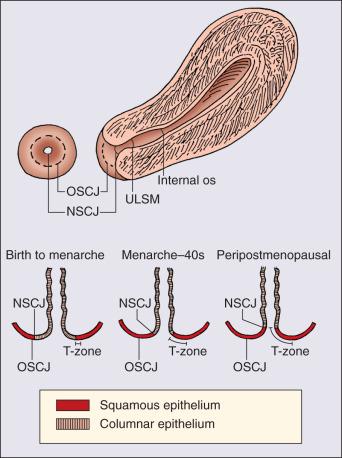
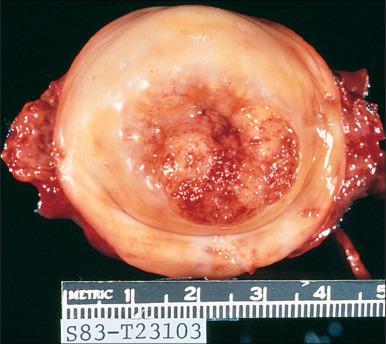
A continuum appears to exist from CIN to frankly invasive squamous cell carcinoma ( Fig. 84.4 ). The mean age of women with CIN is 15.6 years younger than that of women with invasive cancer, suggesting slow progression of CIN to invasive carcinoma. The natural history of HPV infection and CIN in part reflects the host immune system response to the virus. Seventy-five percent of CIN 1 lesions will spontaneously regress or persist as CIN 1, without progression to invasive carcinoma.
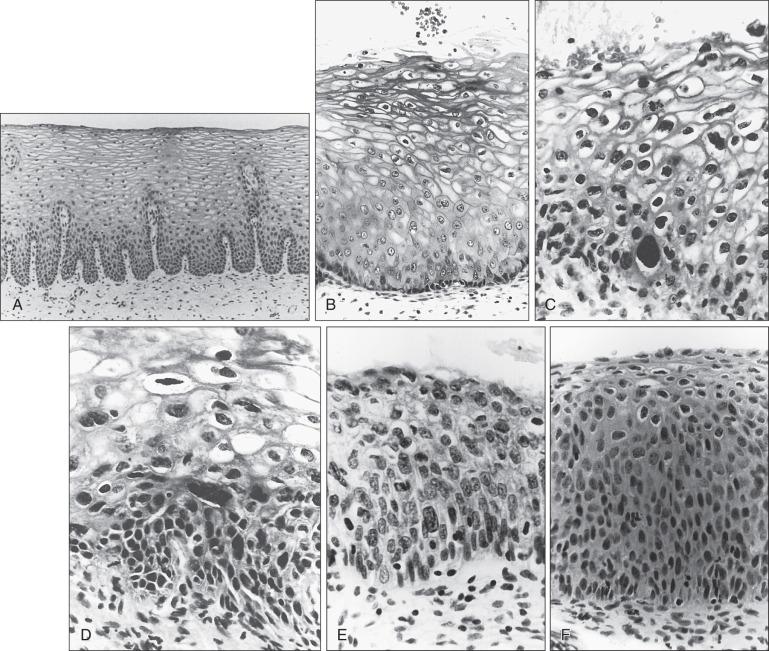
Miller reported that, in a 13-year observational study, only 14% of CIN 3 lesions had progressed, whereas 61% persisted, and the remainder disappeared. Patients taking corticosteroids or other immunosuppressive drugs and patients with HIV infection are at higher risk of progressing to invasive cancer and may have a shorter transit time for this progression.
Approximately 75% of invasive cervical carcinomas are squamous cell carcinomas. Tumor histologic features differ among well, moderately, or poorly differentiated tumors. Squamous carcinomas ( Fig. 84.5 ) may be keratinizing (sometimes containing characteristic keratin pearls) or nonkeratinizing. Large cell and small cell variants exist. True verrucous cancers of the cervix are rare.
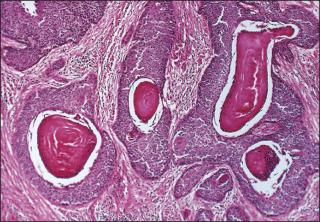
Adenocarcinomas account for 15% to 25% of invasive cervical carcinomas. Typically arising in the endocervix, adenocarcinomas can be more difficult to detect during visual inspection of the cervix. These tumors may infiltrate deeply into the stroma of the cervix, sometimes with parametrial extension and nodal metastases without gross destruction of the exocervix. In addition to the classic endocervical type, histologic variants of adenocarcinoma include endometrioid carcinoma, villoglandular, mesonephric, serous, intestinal-type, and signet ring morphologic types.
Clinically important subtypes also include clear cell adenocarcinomas of the cervix associated with in utero diethylstilbestrol (DES) exposure, which tend to be diagnosed at a younger age than most other adenocarcinomas, and so-called adenoma malignum or minimal deviation adenocarcinoma ( Fig. 84.6 ), an entity associated with deceptively bland or benign-appearing cells, which may be cause for undertreatment of a true malignancy, with a significant likelihood of recurrence even when diagnosed at an early stage.
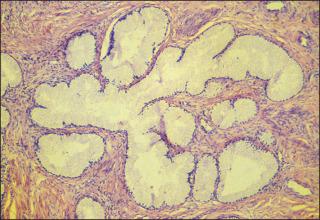
Adenosquamous carcinomas consist of a malignant glandular component and a malignant squamous component and make up approximately one-third of cervical carcinomas with glandular differentiation. Opinions vary regarding the prognosis of adenosquamous carcinoma compared with pure adenocarcinoma or pure squamous carcinoma when prognosis is adjusted for clinical stage at diagnosis. A clinically important variant of adenosquamous carcinoma is the so-called glassy cell carcinoma, thought to represent a very poorly differentiated adenosquamous carcinoma, the name of which derives from the ground-glass or granular appearance of the cytoplasm that is present in many cases. Additional features may include an intense stromal inflammatory infiltrate composed predominantly of eosinophils and plasma cells. Some patients may have accompanying eosinophilia in their circulating blood, with elevated absolute eosinophil counts. This histologic type is associated with a rapid clinical rate of growth, proclivity for early regional dissemination, and increased risk of recurrence after surgical therapy or radiation therapy, even in the absence of other recognized adverse prognostic factors.
Neuroendocrine tumors in the cervix include typical and atypical carcinoid tumors; large cell and small cell neuroendocrine carcinomas; and undifferentiated small cell carcinoma. Both large cell and small cell neuroendocrine tumors resemble similar carcinomas arising in the lung and other aerodigestive sites. Undifferentiated small cell carcinoma is a very poorly differentiated carcinoma with neuroendocrine features, histologically similar to anaplastic small cell carcinoma of the lung. Neuroendocrine carcinomas tend to behave very aggressively, with frequent widespread metastasis to multiple sites, including bone, liver, and skin. Brain metastases may occur when disease is advanced but usually are preceded by lung metastases. Efforts to treat these tumors by using approaches typically used for small cell carcinomas of the lung have had mixed results.
Preinvasive neoplastic disorders of the cervix usually are asymptomatic, hence the need for regular screening by cytologic evaluation of cells collected from the exocervix and endocervix. Early invasive cancers also may be asymptomatic, although some women will notice postcoital, intermenstrual, or postmenopausal spotting. Other symptoms may include malodorous vaginal discharge, dyspareunia, or cramping pelvic pain from uterine contractions caused by the accumulation of blood and uterine deciduas in menstruating patients with occlusion of the endocervical canal. Chronic blood loss may result in symptomatic anemia in some patients. Major hemorrhage is unusual except in locally advanced disease. Pelvic pain, lower extremity swelling (from occlusion of pelvic lymphatics or thrombosis of the external iliac vein), or problems with micturition or defecation indicate advanced regional disease and portend an ominous prognosis. Metastatic disease involving supraclavicular nodes, bones, or lungs can be the cause of presenting symptoms, but rarely in the absence of pelvic symptoms. Constitutional symptoms, including anorexia, dysgeusia, and weight loss, are seen most often in patients with very advanced disease.
Screening for cervical cancer and its precursors with the Pap smear and pelvic examination has resulted in dramatic reductions in cervical cancer mortality in every country where this has been widely used, and is arguably the most effective screening program in effect for any neoplastic disease, in either sex. Table 84.1 outlines the current screening guidelines of the American Cancer Society. The false-negative rate of the Pap smear is approximately 10% to 15% in women with invasive cancer, but the sensitivity, as defined by the detection of biopsy-proven CIN, is 51%. The sensitivity of the test may be improved by ensuring adequate sampling of the squamocolumnar junction and the endocervical canal. Smears without endocervical or metaplastic cells may be inadequate and possibly should be repeated.
Factors contributing to abnormal cytologic smears include the presence of hemorrhage, necrosis, and intense inflammation. Therefore gross symptomatic lesions should be sampled with biopsy rather than assessed with exfoliative cytology.
In the 1980s, cytology laboratories began reporting an increasing number of smears with changes of “squamous atypia” in response to concerns from clinicians over an unacceptably high false-negative cytology rate and increased recognition by cytopathologists of the cytologic changes associated with HPV infection. The use of multiple classification systems with inconsistently defined numeric grading conventions added further imprecision. In an attempt to eliminate confusion among clinicians and cytopathologists, a uniform system for reporting epithelial cell abnormalities was established in 1988 at a National Cancer Institute (NCI) workshop for reporting cervical and vaginal cytologic diagnoses.
The Bethesda system has since been revised, in 1991 and again in 2001, to reflect laboratory and clinical experience gained since the original implementation, and the increased use of new technologies and results from interval research studies. An important contribution of the Bethesda system was the creation of a standardized format and nomenclature for cytology laboratory reports that includes both a descriptive diagnosis and an evaluation of specimen adequacy.
With the formulation of Bethesda 2001, a specimen is designated “satisfactory for evaluation” or “unsatisfactory for evaluation.” The category “satisfactory but limited by …” has been eliminated as confusing. Minimal cellularity requirements for a specimen to qualify as satisfactory depend on specimen type, with an estimated 8000 to 12,000 well-visualized squamous cells for conventional smears and 5000 squamous cells for liquid-based preparations. Comments on partially obscuring inflammation or blood may be added to the “satisfactory” designation, with a specimen considered “partially obscured” when 50% to 75% of the epithelial cells cannot be visualized. When more than 75% of epithelial cells are obscured, a specimen is designated “unsatisfactory.” A notation is made regarding the presence or absence of an endocervical or transformation zone component for specimens with adequate squamous cellularity, with the numeric criterion being at least 10 well-preserved endocervical or squamous metaplastic cells. Cell clusters are not required.
Squamous atypia is a mild cellular abnormality characterized by slight nuclear enlargement and minimal changes of the nuclear chromatin. Cellular changes that show morphologic features of papillomavirus infection or mild CIN (grade 1) are termed low-grade squamous intraepithelial lesions (LSILs). Cellular changes consistent with moderate (CIN 2) or severe (CIN 3) dysplasia are termed high-grade squamous intraepithelial lesions (HSILs). The division of squamous intraepithelial lesions into high- and low-grade strata reflects accumulating evidence that LSIL generally is indicative of transient infection with HPV, particularly in young women, and does not routinely require colposcopy or treatment, whereas HSIL cytology detects precursor lesions that require further evaluation and treatment. Important refinements in the 2001 Bethesda system relate to the reporting of equivocal results. Atypical squamous cells (ASCs) are now further qualified as “of undetermined significance” (ASC-US) or “cannot exclude HSIL” (ASC-H). The qualifier “undetermined significance” was retained, because some cases of ASC-US are associated with underlying CIN 2 or CIN 3. All ASCs are considered to be suggestive of squamous intraepithelial lesions, and thus the category “ASC-US favor reactive” has been eliminated, with a portion of cases previously so designated being downgraded to “negative for intraepithelial lesion or malignancy.” The new term ASC-H includes true HSIL and its mimics and is thought to have a positive predictive value for CIN 2 or CIN 3 intermediate between ASC-US and HSIL. The term atypical glandular cells of undetermined significance ( AGUS ) has been eliminated to avoid confusion with ASC-US. Glandular cell abnormalities now are classified as atypical endocervical, endometrial, or glandular cells. The term atypical epithelial cells may be used when a squamous versus glandular origin cannot be ascertained.
Management of the patient with an abnormal Pap smear with respect to further diagnostic assessments, therapeutic intervention, and subsequent surveillance follow-up is a complex arena in which guidelines continue to evolve. The American Society for Colposcopy and Cervical Pathology (ASCCP) has developed contemporary guidelines for management of cervical cytologic abnormalities and CIN based on current reporting terminology (Bethesda 2001). Techniques for further evaluation can include colposcopy, endocervical curettage (ECC) or brushing, and cervical conization by cold knife or loop electrodiathermy excision procedure (LEEP).
Testing for high-risk, oncogenic HPV DNA synchronously, or subsequent to cytologic screening, is proving to be a useful complementary tool in triage of patients with ASC-US smears, and in determining the need for colposcopy and the intervals for repeated screening. It may be helpful in the follow-up of younger patients with LSIL smears, and a useful tool in identifying older women who can safely be screened at 3-year intervals instead of annually.
HPV triage of patients with an ASC-US smear is at least as sensitive as immediate colposcopy for ultimately detecting CIN 3 and results in referral of about half as many women to colposcopy. A follow-up strategy that uses repeated cytologic assessment is sensitive at an ASC-US referral threshold but requires two follow-up visits and, ultimately, more colposcopic examinations than does HPV triage.
Cytologic and HPV screening in women older than 30 years (after which most sexually active women have been exposed to HPV and have, or have not, spontaneously cleared the infection) may be a mechanism through which low-risk HPV-negative and cytologically negative patients can be identified for whom screening at 3-year intervals is prudent and appropriate.
Patients with a gross lesion of the cervix should undergo cervical biopsy. For patients with abnormal cytologic evaluation findings, without a gross lesion, a colposcopic examination with directed punch biopsies is required. Colposcopy allows the clinician to identify areas suggestive of dysplasia. A 3% acetic acid solution is applied to the cervix for 30 to 90 seconds, which causes a transient reaction with the envelope proteins of the papillomavirus, in addition to producing an osmotic dehydration of the dysplastic cells, thereby accentuating the optically dense chromatin to produce a whitish area. The skilled colposcopist can further distinguish between grades of dysplasia based on acetowhitening and types of vascular patterns ( Fig. 84.7 ). An additional technique to help visualize abnormal areas is the application of quarter-strength Lugol iodine after the initial inspection for acetowhitening. High-grade lesions turn mustard yellow.
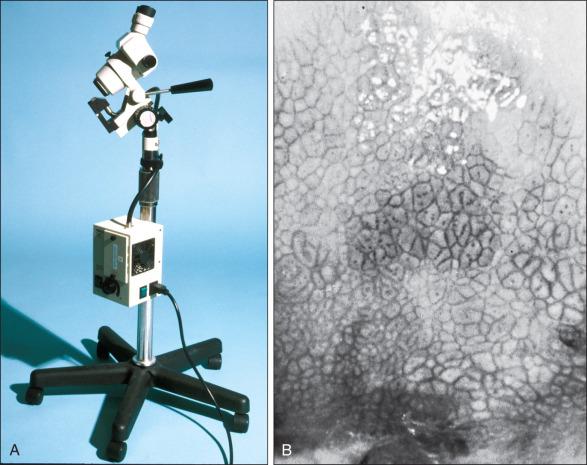
Study of the endocervical canal is required when no abnormalities are found on colposcopic examination, when the entire squamocolumnar junction cannot be visualized, or when atypical endocervical cells are present on Pap smear. Some experts advocate the use of ECC as part of every colposcopic examination to safeguard against missing occult cancer within the endocervical canal. Others reserve ECC for patients with recurrent cytologic atypia after therapy. A sleeved endocervical brush is an alternative to ECC that is less uncomfortable for many patients. A prospective comparison of ECC specimens with sleeved endocervical brush specimens (both obtained from the same patient sequentially after randomization with respect to the order of obtaining specimens) before cervical conization or hysterectomy revealed a higher rate of inadequate specimens from ECC, comparability of the two techniques with respect to sensitivity and specificity in unmatched analysis, and superior sensitivity of the sleeved endocervical brush in matched analysis. Because the sleeved endocervical brush is at least isoeffective and possibly better than ECC but more comfortable for the patient, many clinicians prefer this maneuver, which may serve to increase patient compliance with subsequent surveillance follow-up and repeated assessment.
Diagnostic cervical conization (cone biopsy) leads to an accurate diagnosis and decreases the incidence of inappropriate therapy in the following situations: (1) the squamocolumnar junction is not visualized on colposcopy; (2) dysplastic epithelium extends into the endocervical canal; (3) cytology is suggestive of high-grade dysplasia or worse; (4) microinvasive carcinoma is found at directed biopsy; (5) sampling of the endocervical canal shows high-grade intraepithelial neoplasia; and (6) cytologic findings are suggestive of adenocarcinoma in situ.
LEEP uses wire-loop electrodes in conjunction with a radiofrequency alternating current to excise the entire transformation zone and distal canal under local anesthesia ( Fig. 84.8 ). Compared with ablative procedures, LEEP has the major advantage of obtaining tissue for histologic evaluation. At many centers, LEEP has become the preferred treatment for CIN that can be assessed adequately with colposcopy.
![Figure 84.8, Equipment used for loop electrosurgical excision procedures (loop electrodiathermy excision procedure [LEEP]). (A) LEEP system 6000 (Cooper Surgical). (B) Large loop electrodes used for LEEP. Figure 84.8, Equipment used for loop electrosurgical excision procedures (loop electrodiathermy excision procedure [LEEP]). (A) LEEP system 6000 (Cooper Surgical). (B) Large loop electrodes used for LEEP.](https://storage.googleapis.com/dl.dentistrykey.com/clinical/CancersoftheCervixVulvaandVagina/7_3s20B9780323476744000840.jpg)
Complications include bleeding, with a reported incidence of 1% to 8%, cervical stenosis (1%), and, rarely, pelvic cellulitis or adnexal abscess. In some cases, LEEP may not be an adequate alternative to formal excisional conization, such as in those patients in whom microinvasive or invasive cancer is suspected, or in those with adenocarcinoma in situ, because it may treat disease within the cervical canal inadequately and complicate pathologic interpretation of the specimen. Appropriate application of this technique will yield tissue suitable for pathologic study and reliable diagnosis. Excess heat may result in thermal artifact that can compromise interpretation of margins and the therapeutic adequacy of the LEEP procedure.
Diagnostic or therapeutic excisional conization (cone biopsy) must be performed with the patient under general or regional anesthesia. Complications, which include hemorrhage, sepsis, infertility, stenosis, and cervical incompetence, occur in 2% to 12% of patients, depending on depth and geometry of excision. Width and depth of the cone should be tailored to the topography of the lesion to produce the least amount of injury while providing clear surgical margins. Conization may be performed with a cold knife or a carbon dioxide laser.
A thorough history should be obtained before diagnostic assessments are initiated, because skilled questioning will elicit information that will serve to guide subsequent evaluation. A sexual history should be obtained from all patients, which may alert the physician to screen for HIV and other sexually transmitted diseases. This also will serve to establish a baseline for sexual function and expectations that may be helpful in the posttreatment counseling and sexual rehabilitation of patients after completion of therapy. A complete history and systems review also should assess comorbid conditions (e.g., neurologic, cardiovascular, pulmonary, gastrointestinal, endocrine) that may affect the selection and implementation of treatment strategy.
A social assessment should be routinely performed and will assist in determining supportive interventions that may be necessary to facilitate patient compliance with complex diagnostic programs and multimodality treatment programs. In the United States, patients with advanced cervical cancer may be uninsured or underinsured, often will have cultural or language barriers to obtaining and complying with care, may have limited educational attainment and medical sophistication, and will have variable degrees of familial or other social support.
A general physical examination should be carried out, with attention to accessible lymph node groups, including the supraclavicular nodes and the inguinal nodes. Physical examination also should assess the heart, lungs, and large vasculature (i.e., the carotid, dorsalis pedis, posterior tibial, and femoral arteries; the aorta; and the veins of the lower extremities). Pelvic examination must include meticulous inspection of all potentially visible sites and palpation of the perineum, the vulva, the full length of the vagina, and the anorectum. Some patients will have areas of preinvasive disease at multiple separate sites along the lower reproductive tract or synchronous invasive primary cancers of the lower reproductive tract and the anus, representing “field cancerization” consequent to exposure to a common etiologic agent. Typically, tumors arising from the ectocervix or transformation zone are easily visualized and sampled with biopsy. Occasionally tumors arising in the uterine corpus or lower uterine segment can invade the uterine cervix or protrude through the cervical os, causing confusion in the diagnosis. Often this can be sorted out by histopathologic evaluation and by diagnostic imaging, with magnetic resonance imaging (MRI) being most useful in this context. Once the diagnosis of cervical carcinoma has been established, staging includes careful clinical evaluation of the vagina, cervix, uterus, and parametria. The adnexal areas should also be palpated, because some patients will harbor adnexal pathology (tubo-ovarian abscesses or, less commonly, adnexal metastases) that optimally are diagnosed and addressed before initiation of cancer treatment. These days examination under anesthesia is usually reserved for patients who may need a cystoscopy or proctosigmoidoscopy to rule out bladder or rectal invasion or in patients in whom a thorough examination in the office is difficult, such an overly anxious patient or an elderly patient who has not been sexually active in recent years and has a stenotic vagina.
The revised 2009 staging criteria ( Table 84.2 ) of the International Federation of Gynecology and Obstetrics (FIGO) are a mixture of histopathologic, clinical, and radiographic assessments that reflect the fact that invasive cervical cancer is most prevalent in less-developed portions of the globe where sophisticated and expensive imaging modalities may not be widely available. Cervical cancer is clinically staged, and staging is based primarily on inspection and palpation of the cervix, vagina, parametrium, and pelvic sidewalls. Only the subclassifications of stage I (IA1, IA2) require pathologic assessment. The FIGO staging system permits assessment through biopsy, physical examination, cystoscopy, proctoscopy, excretory urography (intravenous pyelography), and plain film radiography of the chest and skeletal system. Results of lymphangiography, computed tomography (CT), MRI, and positron emission tomography (PET) may be of great value in planning treatment, but do not influence assignment of clinical stage in the FIGO formalism. When findings are equivocal, by convention, a patient is assigned to a lower stage. Once clinical stage has been assigned, it cannot be altered by subsequent events or findings. Findings from surgical evaluation (by laparoscopy or by surgical assessment of retroperitoneal lymph nodes via extraperitoneal or transperitoneal node dissection) will not alter assignment of clinical stage. However, these findings may profoundly influence subsequent treatment. Similarly, evidence of nodal or other spread discerned at the time of hysterectomy does not alter clinical stage.
| FIGO Stage | Definition |
|---|---|
| 1 | Cervical carcinoma confined to uterus (extension to corpus should be disregarded) |
| IA | Invasive carcinoma diagnosed only through microscopy. All macroscopically visible lesions—even with superficial invasion—are T1b/Ib. Stromal invasion with a maximum depth of 5 mm measured from the base of the epithelium and a horizontal spread of 7 mm. Vascular space invasion, venous or lymphatic, does not affect classification |
| IA1 | Measured stromal invasion ≤3 mm in depth and ≤7 mm in horizontal spread |
| IA2 | Measured stromal invasion >3 mm and ≤5 mm with a horizontal spread ≤7 mm |
| IB | Clinically visible lesion confined to the cervix or microscopic lesion greater than T1a2/Ia2 |
| IB1 | Clinically visible lesion ≤4 cm in greatest dimension |
| IB2 | Clinically visible lesions >4 cm in greatest dimension |
| II | Cervical carcinoma invades beyond uterus but not to pelvic wall or to the lower third of vagina |
| IIA | Tumor without parametrial invasion |
| IIA1 | Clinical visible lesion ≤4 cm in greatest dimension |
| IIB2 | Clinical visible lesion >4 cm in greatest dimension |
| IIB | Tumor with parametrial invasion |
| III | Tumor extends to the pelvic wall, and/or involves the lower third of the vagina, and/or causes hydronephrosis or nonfunctioning kidney |
| IIIA | Tumor involves lower third of the vagina, no extension to pelvic wall |
| IIIB | Tumor extends to pelvic wall and/or causes hydronephrosis or nonfunctioning kidney |
| IVA | Tumor invades mucosa of the bladder or rectum, and/or extends beyond true pelvis (bullous edema is not sufficient to classify a tumor as T4) |
| IVB | Distant metastasis |
A staging system based largely on findings from clinical pelvic examination is inherently imprecise and somewhat subjective, with overstaging and understaging of the parametria being the most problematic issue and the one most likely to alter management. However, FIGO stage does correlate with prognosis and does permit cautious interinstitutional and intrainstitutional comparisons of treatment outcomes.
The goals of clinical staging in patients with invasive disease include determining the appropriateness and extent of initial surgical treatment, as opposed to initial treatment with combined radiation therapy and synchronous chemotherapy. Although not formally part of clinical staging, modern sophisticated diagnostic imaging can enhance clinical assessment of disease volume and extent in women with cervical carcinoma, thus refining both selection of treatment and technical implementation of treatment modalities.
The FIGO staging system is based predominantly on clinical examination under anesthesia, ultrasonography, intravenous urography, cystoscopy, proctoscopy, and chest radiography. Significant inaccuracies occur with use of this staging system because of possible errors in gynecologic examination (24%–39%). The various imaging modalities have a complementary role in the accurate staging and complete evaluation of the cancer, with important therapeutic implications.
Today, clinicians most often obtain a contrast-enhanced CT scan of the abdomen and pelvis for patients with disease of stage IB2 or greater ( Fig. 84.9 ). Lymph nodes larger than 1.0 to 1.5 cm in diameter are suspicious for tumor involvement and should undergo biopsy. Unfortunately, microscopic metastases are not readily detected with CT, and the inflammation commonly associated with advanced disease may cause enlargement of nodes that do not contain metastases. The sensitivity of MRI in the detection of regional metastases is similar to that of CT. However, MRI provides better anatomic delineation and accurate estimation of the tumor size, volume, and local extent within the pelvis, which can influence the choice of therapy ( Fig. 84.10 ). Involvement of the vagina, parametrium, pelvic wall muscles, ureter, bladder, and rectum can be better assessed with MRI for accurate staging ( Fig. 84.11 ). MRI before and after vaginal opacification with contrast medium can be used if imaging evaluation of the vaginal wall or fornices is required. T2-weighted images obtained by using phased-array coil, fast spin-echo or conventional spin-echo techniques are accurate in local staging and lymph nodal assessment; the former technique is faster with increased resolution. Dynamic contrast-enhanced T1-weighted images are helpful in identifying smaller tumors, fistulous tracts, and invasion into bladder and rectum. Dynamic contrast-enhanced imaging is useful in differentiating areas composed predominantly of tumor cells (well-enhanced areas) from those of fibrous tissue with scattered cancer cells (poorly enhanced areas). This information can be helpful, because radiation therapy is more effective in well-enhanced tumors.
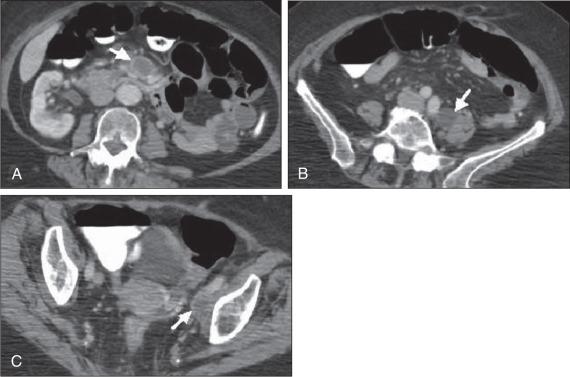
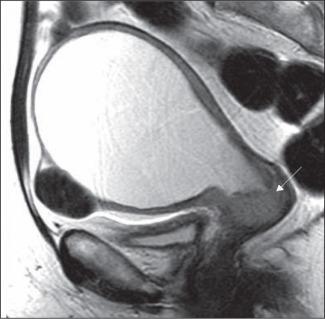
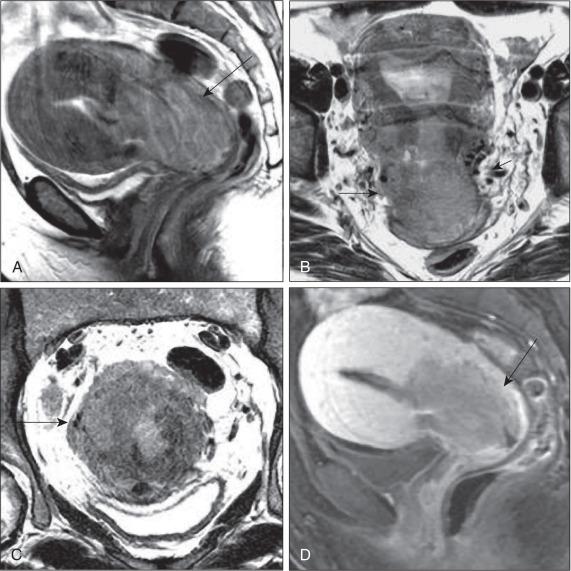
MRI is very useful in the evaluation of tumor volume and enlarged lymph nodes, inherently important prognostic factors and determinants of the design of radiation treatment ports and selection of radiation dose. However, MRI cannot depict micrometastases to lymph nodes or differentiate malignant from nonmalignant enlargement. MRI with newer contrast agents such as ultrasmall superparamagnetic iron oxide has been useful in distinguishing benign from malignant nodes. The shape, volume, and direction of the growth of the tumor can be well assessed, and these are crucial for planning brachytherapy and external beam radiotherapy. MRI also is useful in the follow-up evaluation of the tumor, its response to treatment, and identification of recurrences. However, benign conditions, such as edema or inflammation, sometimes cannot be differentiated from tumors. Dynamic contrast-enhanced MRI is useful in differentiating malignant lesions that usually have shorter and stronger enhancement than benign conditions in patients who have abnormalities after treatment for cervical cancer.
Studies have suggested that fluorine-18 ( 18 F) fluorodeoxyglucose–positron emission tomography (FDG-PET) is more sensitive and specific than more standard radiographic studies in the detection of lymph node involvement by cervical cancer. Grigsby and colleagues reported a strong correlation between abnormal posttherapy FDG uptake and tumor recurrence. PET scans are now Medicare approved and considered standard of care for staging purposes for all newly diagnosed cervical carcinomas.
Routine laboratory assessment should include complete blood counts with differential counts and red cell indices. Many patients with advanced disease will be anemic at the time of diagnosis, often reflecting chronic blood loss and iron deficiency. Anemic patients treated with radiation or chemoradiation have poorer outcomes than do patients with near-normal hemoglobin levels. Anemia at diagnosis (before treatment) correlates significantly with reduced pelvic control and survival with univariate analysis, but not always when data are subjected to multivariate analysis. In contrast, multivariate analysis reveals that hemoglobin level during the course of radiation therapy or chemoradiation is a robust predictor of local outcome and survival. Transfusion for anemic patients with maintenance of average weekly nadir hemoglobin levels at or above 11 to 12 g/dL through radiation therapy is associated with improvement in prognosis compared with that in patients with near-normal or normal hemoglobin levels at diagnosis. This effect may be partially mediated through better tumor oxygenation and oxygen-enhanced radiation lethality to clonogenic cells, and reduced angiogenesis in better-oxygenated tumors. With pelvic or extended-field radiation that will encompass a substantial percentage of adult bone marrow, hemoglobin may decline slowly, even when adequate iron stores are present and patients are supported with hematinics. Concurrent administration of cisplatin further aggravates this problem and can result in clinically significant reduction in hemoglobin levels over the course of a 6- to 8-week program of chemoradiation, even in patients with normal hemoglobin levels at the time of diagnosis. Frequent monitoring of hemoglobin levels and white cell counts and platelets should be performed throughout a course of chemoradiation, and hemoglobin level should be supported, either by transfusion or through the use of recombinant erythropoietin. The minimal hemoglobin level required is uncertain, but it seems prudent to target a minimum of 10 g/dL.
Neutropenia may indicate supportive treatment with granulocyte colony-stimulating factor to avoid prolonged treatment interruptions that are known to adversely affect local tumor control in patients treated with radiation. Absolute neutrophil counts should be monitored at least weekly in patients undergoing chemoradiation.
An elevated platelet count has been associated with advanced malignancy and is considered a consequence of increased platelet production. Hernandez and associates identified this effect in advanced cervical cancer, and Rodriguez and coworkers identified the preoperative platelet count as an adverse prognostic factor, even for patients with stage IB cervical carcinoma. The cumulative 5-year survival of women with a platelet count greater than 300,000 (85 women) was 65%, compared with 84% for the group with a normal value (134 women). At issue was the question of whether the value could have been elevated simply because of bleeding from the primary tumor, but no association was found with the preoperative hematocrit. This study of surgically treated patients with early disease also demonstrated that the effect was not a consequence of metastatic disease and did correlate with tumor volume, with nearly half of the patients with platelet counts in excess of 300,000 having “large” lesion size, in contrast to only 28% (32 of 114) patients with normal counts. In a multivariate analysis, adjusting for age, race, tumor size, and presence of lymph node metastases, high platelet count was still associated with an adverse prognosis.
Additional laboratory tests should include a complete chemistry panel with serum electrolytes and measurements of renal and hepatic function. Electrolytes and renal function should be monitored repeatedly through a course of chemoradiation. Creatinine may be elevated secondary to hydroureter or hydronephrosis that may necessitate ureteral stent placement or nephrostomies before radiation therapy, particularly if cisplatin chemotherapy is anticipated. Serum sodium and potassium may become abnormal during the course of chemoradiation, particularly in elderly patients, consequent to diarrhea with potassium loss, inadequate oral replenishment, and inadequate or inappropriate fluid intake.
Prognostic factors fall into two groups: tumor-related factors and patient-related factors. Probably the most important tumor-related factor is tumor size, and this is true both for patients treated with hysterectomy and for patients treated with radiation therapy. In fact, FIGO, in 1995, divided stage IB into two groups according to size; other stage categories act, in part, as surrogates for tumor size. For patients treated with surgery, histologic evidence of extracervical spread is associated with a poorer prognosis. Parametrial extension is associated with a higher rate of lymph node involvement, local recurrence, and death from cancer. Uterine body involvement is associated with an increased rate of distant metastases in patients treated with radiation therapy or surgery.
Lymph node involvement is another important tumor-related factor. After radical hysterectomy, reported-year survival rates usually are about 35% to 40% lower when the pelvic lymph nodes are involved. However, studies have suggested that postoperative chemoradiation improves these results. Several reports have indicated that survival decreases with increasing size of the largest involved nodes, increasing number of nodes involved, and increasing level of regional involvement and with extent of central disease in the cervix. Overall, the survival rates for patients with positive paraaortic nodes are about half those of patients who have similar stages of disease without paraaortic lymph node involvement. Lymphovascular space invasion (LVSI) also is correlated with an increased risk of recurrence. This reflects, in part, the strong correlation between LVSI and lymph node involvement; however, in a large number of postoperative studies, LVSI is an independent predictor of prognosis.
Investigators have compared the outcomes of patients with adenocarcinomas versus those with squamous carcinomas and have reached varying conclusions about the relative prognoses of the two histologic types of cervical cancer. In a review of 1767 patients with stage IB disease (229 with adenocarcinoma), Eifel and colleagues found that patients with adenocarcinoma had a significantly higher risk of recurrence and death from disease, independent of age, tumor size, or tumor morphologic features. The rate of distant metastasis in patients with bulky (>4 cm) adenocarcinomas was almost twice that in patients with squamous carcinoma (37% versus 21%; P < .01). Several investigators have reported high recurrence rates after radical hysterectomy for adenocarcinomas. In a subset analysis of a randomized Gynecologic Oncology Group (GOG) study, Rotman and associates reported a high recurrence rate (11 of 25 patients [44%]) after treatment with radical hysterectomy alone for adeno-adenosquamous carcinomas of the cervix; in contrast, only 3 of 31 patients (10%) who received postoperative radiation therapy had recurrences. However, all of these comparisons had a relatively small number of patients treated with cervical adenocarcinomas.
Other tumor factors include correlation between the serum concentration of squamous cell carcinoma antigen and the extent of squamous carcinoma of the cervix. Increased tumor vascularity has been associated with a relatively poor prognosis, and a strong inflammatory response in the cervical stroma tends to predict a good outcome. Some authors have reported a correlation between HPV subtype and prognosis. Several investigators have reported a higher recurrence rate in patients with histologically negative lymph nodes when a polymerase chain reaction assay of the lymph nodes was strongly positive for HPV DNA. Other authors have correlated poor prognosis with the presence of HPV messenger RNA or HPV-related proteins in the peripheral blood of cervical cancer patients.
Patient-related factors are discussed elsewhere in this chapter and include age, hemoglobin, platelet counts, race, and smoking. Several studies have demonstrated that in the United States, women of color with invasive cervical cancer have higher-stage disease and lower hemoglobin levels at presentation than do white women. Differences in socioeconomic status may influence minority patients’ access to care and ability to comply with treatment recommendations. In a study of 1304 women treated with radiation for cervical cancer, Kucera and colleagues reported that smokers with cervical cancer had a poorer 5-year survival rate than nonsmokers. This difference was statistically significant for patients with stage III disease (5-year survival rate 20.3% versus 33.9%; P < .01). However, the authors did not analyze the possible influence of smoking-related deaths from causes other than cervical cancer.
The treatment of patients with cervical cancer is determined primarily by the stage and extent of disease. As a general rule, CIS and microinvasive cervical cancer with no more than 3 mm of stromal invasion and no more than 7 mm breadth (FIGO stage IA1) are managed with conservative surgery (excisional conization or extrafascial or simple hysterectomy). Microinvasive cervical cancer with 3 to 5 mm of stromal invasion and no more than 7 mm breadth (FIGO stage IA2) may be managed with trachelectomy, simple hysterectomy, or modified radical hysterectomy. Stage IB1 and small-volume stage IIA disease may be managed with either surgery (in general, radical hysterectomy or modified radical hysterectomy), fertility-sparing surgery if less than 2 cm, radiation alone, or chemoradiation. Controversies surround the optimal management of patients with bulky stage IB2 (>4 cm) cancer, who may be treated with triple-modality therapy in selected instances (surgery, radiation, and chemotherapy in a variety of possible sequences).
After initial radical surgical therapy, patients with adverse histopathologic factors may be advised to undergo adjuvant pelvic radiation or adjuvant chemoradiation. Risk factors for recurrence include metastatic disease in regional nodes, positive surgical margins, parametrial extension, deep cervical stromal invasion, LVSI, and large tumor size.
Patients with large FIGO stage IIA or with stages IIB through IVA disease usually are managed with chemoradiation. Some patients with an incomplete response to chemoradiation may benefit from a combined approach using adjunctive hysterectomy to clear persistent central disease after chemoradiation. Patients with bulky IB2 or IIA disease and rare patients with bulky central stage IIB lesions with minimal, medial parametrial invasion may be considered for this approach. For patients in whom disease recurs centrally in the pelvis after maximal chemoradiation, radical exenterative surgery can be performed, provided that no distant disease is present. Optimal candidates have mobile central disease without lymph node involvement. Intraoperative radiation therapy may be part of salvage surgery when lateral or posterior surgical margins will be predictably inadequate. Recurrent disease after initial radical surgery historically has been treated with salvage radiation, but currently should be treated with chemoradiation.
A major deficiency of all ablative therapies is the absence of full histopathologic assessment of the lesion treated, and the hazard of undertreatment of an occult invasive lesion. For this reason, use of ablative techniques is declining. Three superficial ablative techniques used historically are electrocoagulation diathermy, cryosurgery, and CO 2 laser therapy.
Hysterectomy involves the removal of the uterus and varying amounts of surrounding tissue ( Fig. 84.12 ). Because the risk of ovarian metastases is low (0.5%), ovarian preservation usually is recommended in premenopausal women, obviating the need for hormone replacement therapy. An important exception is when nodal metastases from a primary cervical adenocarcinoma are detected intraoperatively, when the risk of ovarian metastasis escalates steeply, perhaps to as high as 25%. Five types of hysterectomy have been described.
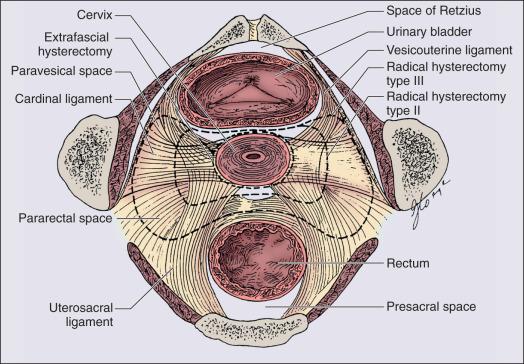
Extrafascial or simple hysterectomy involves the removal of the cervix, adjacent tissues, and a small cuff of the upper vagina in a plane outside the pubocervical fascia; it is appropriate treatment for stage IA1 disease. Minimal disturbance occurs to the bladder and ureters, which decreases the risk of urinary complications.
Modified radical or Wertheim hysterectomy , less extensive than radical hysterectomy, involves removal of the cervix and proximal 1 to 2 cm of vagina, including the paracervical and parametrial tissues. The ureters are dissected to the point of entry to the bladder to allow safe removal of parametrial and paracervical tissue. The medial half of the cardinal ligaments and the uterosacral ligaments also are removed.
A radical ( Meigs ) hysterectomy includes removal of the uterus, cervix, and paracervical, parametrial, and paravaginal tissues to the pelvic sidewalls bilaterally in continuity, with as much of the uterosacral ligaments as possible. The uterine vessels are ligated at their origin, and the proximal one-fourth to one-third of the vagina and paracolpos is resected. This operation usually is performed in conjunction with bilateral therapeutic pelvic lymphadenectomies. Acute complications include blood loss (average, 800 mL), ureterovaginal fistula (1%–2%), vesicovaginal fistula (<1%), pulmonary embolus (1%–2%), small bowel obstruction (1%), and febrile morbidity (25%–50%). Subacute complications include transient bladder dysfunction lasting 1 to 7 weeks (30%) and lymphocyst formation (<5%). Chronic complications include bladder hypotonia and atonia in approximately 3% of patients and, uncommonly, ureteral strictures. Rare patients may have transient or permanent lower extremity lymphedema.
In addition to the tissue removed in type III hysterectomy, extended radical hysterectomy involves removal of the periureteral tissue, the superior vesicle artery, and up to three-fourths of the vagina. This procedure is rarely done, because patients with the anatomic extent of disease that would warrant such treatment generally should be treated with chemoradiation.
Partial exenteration is rarely performed, because radiation therapy should be used for patients with the extent of disease that would require surgery of this extent for gross anatomic clearance. Parts of the distal ureters and bladder are resected in this procedure. This may be appropriate initial surgery for patients with FIGO stage IVA cancer with large vesicovaginal fistulas and incontinence. However, vesicovaginal fistulas may scar closed in some patients after high-dose radiation therapy if the upper vagina is permitted to fuse shut, thus restoring urinary continence.
The late 1980s and the 1990s witnessed a proliferation of surgical techniques consequent to the availability of the sophisticated instruments and optical equipment required for laparoscopic surgery, a resurgence of interest in vaginal hysterectomy, and concerns about preserving reproductive potential in young women with early cervical cancer.
Radical vaginal hysterectomy carried out with the methods of Schauta-Stoeckel (less radical) or Schauta-Amreich (more radical) is a surgical alternative to radical or modified radical abdominal hysterectomy (types II and III) that may be associated with shorter hospital stays and more rapid recuperation. Laparoscopic or robotic-assisted radical hysterectomy is an operation comparable to a radical hysterectomy (type III hysterectomy) performed entirely through the laparoscope or robotic system, including the vaginal closure.
Laparoscopy and robotic-assisted techniques have been coordinated with vaginal hysterectomy, with varying amounts of surgery being carried out via the laparoscopic or robotic-assisted approach, ranging from pelvic and paraaortic lymphadenectomy to lymphadenectomy plus important components of the radical hysterectomy.
Radical trachelectomy is an operation suitable for selected patients with small, generally exophytic squamous tumors (usually <2 cm, although some patients with larger tumors have been treated in this fashion) involving primarily the cervix who desire conservation of reproductive capacity. In this operation, the main trunk of the uterine artery is preserved, although branches to the cervix and vaginal fornices are sacrificed before amputation of the cervix at a point approximately 5 mm caudal to the uterine isthmus. The uterus is suspended from the lateral stumps of the transected paracervical ligaments. Isthmic cerclage is performed in a fashion similar to that used as prophylaxis against miscarriage, and an anastomosis between the vaginal mucosa and the isthmic mucosa is performed. Variations on this procedure can be performed vaginally with laparoscopy, or abdominally. The margin between the superior extent of the tumor and the uterine isthmus must be a minimum of 1.5 cm, but 2 cm is preferable. MRI can be used preoperatively to assist in patient selection for this procedure. Intraoperative assessment by inspection of the trachelectomy specimen and frozen-section pathologic study are done to ensure an adequate surgical margin, and patients must be prepared for hysterectomy in the eventuality that a satisfactory margin cannot be obtained. Numerous successful pregnancies have been reported after such operations, although the risk of miscarriage is increased. In carefully selected patients, the risk of cancer recurrence is very small.
Damage to the pelvic autonomic nerves during radical hysterectomy is responsible for much of the late morbidity after surgical treatment of FIGO stages IA2 to IIA cervical cancer, including problems with bladder function, defecation, and sexual dysfunction. Nerve-sparing radical abdominal hysterectomy endeavors to spare important components of the autonomic innervation of the true pelvis by identification and preservation of the hypogastric nerves, which carry sympathetic fibers; the inferior hypogastric plexus formed from the fusion of the hypogastric nerves with fibers of the pelvic splanchnic nerves derived from sacral roots S2 to S4, which carry parasympathetic fibers; and the most distal part of the hypogastric plexus, which extends to the lateral vaginal wall and the base of the bladder. In aggregate, these structures are important in controlling bladder compliance, urinary continence, vaginal lubrication and genital engorgement during sexual arousal, small muscle contractions with orgasm, and some rectal functions. This recent surgical innovation is intended not to compromise the efficacy of the cancer surgery while preserving important components of quality of life in cancer survivors. Precise criteria for patient selection have not been defined.
Become a Clinical Tree membership for Full access and enjoy Unlimited articles
If you are a member. Log in here